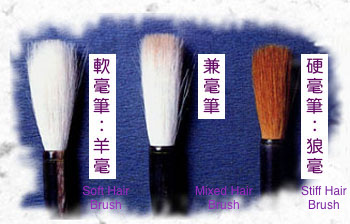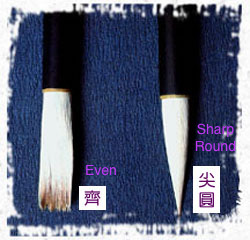Inspired by the striking ink characters set on milky rice paper? The first place to start is by getting yourself a calligraphy brush, one of the four treasures of the study room. Calligraphy writing and painting are both accomplished with this same crucial tool. Ink brushes are quite similar across Asian culture, given that Japanese calligraphy finds its origins in Chinese calligraphy.
History of Chinese Calligraphy Brushes
The Chinese calligraphy brush was purported to be invented by General Meng Tian of the Qin Dynasty. Archaelogical finds have revealed that even earlier in the Warring states period there were already Chinese calligraphy brushes. Even the Nara prefecture in Japan claims to have the world’s oldest calligraphy brush. It goes without saying that the ink brush has been developed over an extremely long period.
How Brushes Are Made
The Chinese calligraphy brush is literally named “Hairy brush/pen”, and as the name implies, consists of a tubular pen structure combined with fine hair. The tube of the brush is typically made of bamboo, though in modern times plastic is often used.
Many types of fine hair are used within the calligraphy brush with qualities ranging from soft to stiff. Animal hair from sheep, wolves, rabbits are most commonly used, though hairs from bulls, horses, and pheasants have also been used.
Ink calligraphy brushes have to be carefully crafted by experts, who take the various animal hairs and soak them in lime water to remove grease. They then use bamboo strips to comb the hairs before selecting an appropriate mixture of soft, stiff, short, and long hairs. In general, calligraphy brushes can be divided into three categories: soft, hard, and mixed hair.
Types of Chinese Calligraphy Brushes

- Soft brushes are typically made of sheep hair. Pheasant hair is also quite soft, though relatively rare. Sheep hair is generally fairly plentiful and cheap and can be used for long front end brushes長鋒筆. Soft brushes such as these absorb water very well and are great for writing large characters. They’re also versatile enough for writing seal script, clerical script, and even running script. 篆字、隸書, 行草
- Stiff haired brushes usually consist of mountain rabbit hair, weasel hair, wild horse hair, bobcat hair,, purple rabbit hair system. These brushes are generally more expensive, but stiff haired brushes can be used to control the thickness of strokes easier. Writing stellar, longer strokes is simpler, but the brush has a stiffer edge which can result in sharper strokes, while sheep hair is more subtle.
- 兼毫筆 Mixed hair calligraphy brushes are made of two or more kinds of animal hair. This type of calligraphy ink brush combines a ratio of soft and stiff hairs so create a stiffness somewhere between the two extremes. As a result it has properties of both stiff and soft brushes, and can be compared to the長流筆 (long flowing brush) the Japanese make.
Choosing A Calligraphy Brush
Brushes have different personalities, so to speak, and when choosing the ink brush, we need to know what type of characters you’d like to write. For bolder, stiffer characters, stiff brushes are appropriate. For more rounded softer looking characters, softer brushes are better. During normal practice, a mixed hair brush is best. A great brush should exhibit the four characteristics: “sharp, round, even, strong.”

- 尖 Sharp – means the tip of the brush must have the ability to form together into a sharp pointed tip. When wet there shouldn’t be divets that look like bites have been taken out of the brush.
- 圓 Round- When the hairs are gathered together, there should be and abundance and fullness of hair. The tip of the brush should not be concave凹 or convex凸, flat or thin.
- 齊 Even – When the tip is squeezed flat and hairs are separated from one another, the inner and outer hairs, the lengths of the hair should be the same, even and neat.
- 健 Strong – Each hair is vertical, and when gathered or separated the brush does not become deformed. This denotes a naturally strong and healthy brush.
How To Maintain A Brush
How do you protect and maintain a calligraphy brush?
Preparing A New Brush For Use:
- Rinse new brushes using clear water to wash away any glue off the tip of the pen.
- Allow the tip to separate by soaking if necessary, then use your fingers to squeeze excess water off the pen, leaving the hairs straight. After this the brush can be dipped in ink.
For Ongoing Maintenance:
- When not in use, wash the brush clean, and ensure there’s no residual ink where the brush tube meets the hairs.
- If rinsing the brush under the faucet, hold the brush hairs in the same direction as the water flows. After cleaning, squeeze the brush hairs dry and hang the pen vertically to dry.
- Next time you want to use the brush, dip it in water and squeeze off excess water before using.
Following these tips will ensure the longevity of your brush and allow you to write the highest quality calligraphy!
